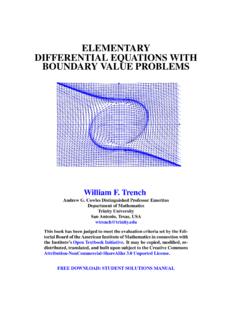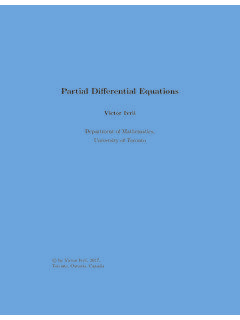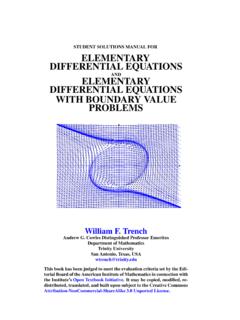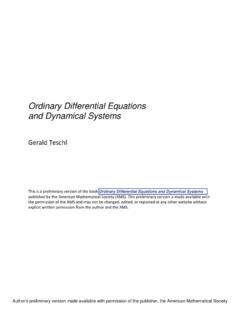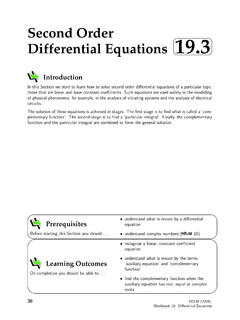Transcription of First Order Partial Differential Equations, Part - 1 ...
1 First Order Partial Differential equations , Part - 1:Single linear and Quasilinear First Order EquationsPHOOLAN PRASADDEPARTMENT OF MATHEMATICSINDIAN INSTITUTE OF SCIENCE, BANGALORED efinitionFirst Order PDE in two independent variables is a relationF(x,y;u;ux,uy) = 0Fa knownrealfunction fromD3 R5 R(1)Examples: linear , semilinear, quasilinear, nonlinear equations -ux+uy= 0ux+uy=ku, candkare constantux+uy=u2uux+uy= 0u2x u2y= 0u2x+u2y+ 1 = 0ux+ 1 u2y= 0,defined for|uy| 1(2)A Model Lession FD PDE Part 1P. PrasadDepartment of Mathematics2 / 50 Symbols for various domains usedIn this lecture we denotebyDa domain inR2where a solution is defined,byD1a domain inR2where the coefficients of alinear equation are defined andbyD2is a domain in (x,y,u)-space ,R3finally byD3a domain inR5where the functionFof five independent variables is Model Lession FD PDE Part 1P.
2 PrasadDepartment of Mathematics3 / 50 Meaning of a classical (genuine) solutionu(x,y)uis defined on a domainD R2u C1(D)(x,y,u(x,y),ux(x,y),uy(x,y)) D3when(x,y) DF(x,y;u(x,y);ux(x,y),uy(x,y)) = 0 (x,y) call a classical solution simplya ,generalizedorweak Model Lession FD PDE Part 1P. PrasadDepartment of Mathematics4 / 50 ClassificationLinear equation:a(x,y)ux+b(x,y)uy=c1(x,y)u+c2(x ,y)(3)Non linear equation: All other equations with subclassesSemilinear equation:a(x,y)ux+b(x,y)uy=c(x,y,u)(4)Qu asilinear equation:a(x,y,u)ux+b(x,y,u)uy=c(x,y,u)( 5)Nonlinear equation:F(x,y;u;ux,uy) = 0 whereFis not linear inux, of solutions of all 4 classes of equations are Model Lession FD PDE Part 1P.
3 PrasadDepartment of Mathematics5 / 50 Example 2ux= 0 General solution inD=R2u=f(y),fis an uniquely determined ifuis prescribed on any curve nowhere parallel tox-axis. On a line parallel tox-axis, we can Model Lession FD PDE Part 1P. PrasadDepartment of Mathematics6 / 50 Example 3uy= 0(6)General solution inD=R2u=f(x), f C1(R).(7)A Model Lession FD PDE Part 1P. PrasadDepartment of Mathematics7 / 50 Directional derivativeux= 0 means rate of change ofuin direction (1,0) parallel tox axisis (1,0).(ux,uy) = 0We sayux= 0 is a directional derivative in the direction (1,0).Consider a curve with parametric representationx=x( ),y=y( )given byODEdxd =a(x,y),dyd =b(x,y)(8)Tangent direction of the curve at (x,y):(a(x,y),b(x,y))(9)A Model Lession FD PDE Part 1P.
4 PrasadDepartment of Mathematics8 / 50 Directional derivative of change ofu(x,y) with as we move along thiscurve isdud =uxdxd +uydyd =a(x,y)ux+b(x,y)uy(10)which is a directional derivative in the direction (a,b)at (x,y)Ifusatisfies PDEaux+buy=c(x,y,u) thendud =c(x,y,u)(11)A Model Lession FD PDE Part 1P. PrasadDepartment of Mathematics9 / 50 Characteristic equation and compatibilityconditionFor the PDEa(x,y)ux+b(x,y)uy=c(x,y)(12)Character istic equationsdxd =a(x,y),dyd =b(x,y)(13)and compatibility conditiondud =c(x,y)(14)(14) and (15) witha(x,y)6= 0 characteristic equations givedydx=b(x,y)a(x,y)(15)compatibility condition becomesdudx=c(x,y)a(x,y)(16)A Model Lession FD PDE Part 1P.
5 PrasadDepartment of Mathematics10 /50 Example 4yux xuy= 0(17)Characteristic equations aredxd =y,dyd = x(18)ordydx= xy y dy+x dx= 0 x2+y2= constant.(19)Thecharacteristic curvesare circles with centreat (0,0).A Model Lession FD PDE Part 1P. PrasadDepartment of Mathematics11 /50 Example 4 conditions along these curves aredud = 0 u= constant.(20)Hence value ofuat (x,y) = value ofuat ( x, y).uis an even function ofxand also Model Lession FD PDE Part 1P. PrasadDepartment of Mathematics12 /50 Example 4 this even function be of the formu=f(x2+y4)?The informationu= constant on the circlesx2+y2= constant u=f(x2+y2)wheref C1(R) is solution is of this an even function ofxandybut of a Model Lession FD PDE Part 1P.
6 PrasadDepartment of Mathematics13 /50 linear First Order PDEa(x,y)ux+b(x,y)uy=c1(x,y)u+c2(x,y)(21 )Letw(x,y) be any solution of the nonhomogeneousequation (21). Setu=v+w(x,y) vsatisfies the homogeneous equationa(x,y)vx+b(x,y)vy=c1(x,y)v(22)Le tf(x,y) be a general solution of (22) u=f(x,y) +w(x,y)(23)A Model Lession FD PDE Part 1P. PrasadDepartment of Mathematics14 /50 Example 5: Equation with constant coefficientsaux+buy=c, a,b,care constants(24)For the homogeneous equation,c= 0, characteristicequation (witha6= 0)dydx=ba ay bx= constant(25)Along thesedudx= 0 u= constant(26)Henceu=f(ay bx) is general solution of thehomogeneous Model Lession FD PDE Part 1P.
7 PrasadDepartment of Mathematics15 /50 Example 5: Equation with constant the nonhomogeneous equation, the compatibility conditiondudx=ca u= const +cax(27)The constant here is constant along the characteristicsay bx= general solutionu=f(ay bx) +cax.(28)Alternativelyu=caxis a particular solution. Hence the of a PDE contains arbitrary elements. For a First orderPDE, it is an arbitrary applications - additional condition Cauchy Model Lession FD PDE Part 1P. PrasadDepartment of Mathematics16 /50 The Cauchy Problem forF(x,y;u;ux,uy) = 0 Piecewise smooth curve :x=x0( ), y=y0( ), I Ra given functionu0( ) on Find a solutionu(x,y) in a neighbourhood of The solution takes the prescribed valueu0( ) on (x0( ),y0( )) =u0( )(29)Existence and uniqueness of solution of a Cauchyproblem requires restrictions on , the functionFandthe Cauchy datau0( ).
8 A Model Lession FD PDE Part 1P. PrasadDepartment of Mathematics17 /50 The Cauchy Problem Model Lession FD PDE Part 1P. PrasadDepartment of Mathematics18 /50 Example 6aSolveyux xuy= 0 inR2withu(x,0) =x,x RThe solution must be an even function the Cauchy data is an odd does not 6bSolveyux xuy= 0in a domainDu(x,0) =x, x R+(30)A Model Lession FD PDE Part 1P. PrasadDepartment of Mathematics19 /50 Example 6b isu(x,y) = (x2+y2)1/2, verify with partialderivativesux=x(x2+y2)1/2,uy=y(x2 +y2)1/2(31)Solution is determined inR2\{(0,0)}.A Model Lession FD PDE Part 1P. PrasadDepartment of Mathematics20 /50 Example 7 Cauchy problem: Solve2ux+ 3uy= 1with datau| =u( , ) =u0( ) on : x y= 0; , = constantCharacteristic curve through an arbitrary pointP (x ,y ) in(x,y)- = 2,dyd = 3 x=x + 2 , y=y + 3 is a straight line3x 2y= 3x 2y A Model Lession FD PDE Part 1P.
9 PrasadDepartment of Mathematics21 /50 Example 7 lies on , x = ,y = , the characteristiccurves arex= + 2 , y= + 3 , = const, variesA Model Lession FD PDE Part 1P. PrasadDepartment of Mathematics22 /50 Example 7 conditiondud = 1 u=u0(x ,y ) + (32)WhenP lies on u=u( , ) + =u0( ) + (33)Solution of the Cauchy problemSolvex= + 2 , y= + 3 for and = x y2 3 , =2y 3x2 3 (34)Substitute in expression foruu(x,y) = x y2 3 +u0(2y 3x2 3 )(35)A Model Lession FD PDE Part 1P. PrasadDepartment of Mathematics23 /50 Example 7 Existence and UniquenessThe solution exists as long as 2 3 6= 0 , thedatum curve is not a characteristic curveUniqueness:Compatibility condition carries information on thevariation ofualong a characteristic in unique leads to happens when 2 3 = 0?
10 A Model Lession FD PDE Part 1P. PrasadDepartment of Mathematics24 /50 Example 8: Characteristic Cauchy problem2 3 = 0 datum curve is a characteristic curveChoose = 2, = 3 x= 2 ,y= 3 A Model Lession FD PDE Part 1P. PrasadDepartment of Mathematics25 /50 Example 8: Characteristic Cauchy characteristic Cauchy problem: Solve2ux+ 3uy= 1with datau(2 ,3 ) =u0( ) =u0(12x)Sincedu0( )d =dd u(2 ,3 ) = 2ux+ 3uy= 1,using PDE(36)The Cauchy datau0cannot be prescribed arbitrarily on .u0( ) = =12x, ignoring constant of Model Lession FD PDE Part 1P. PrasadDepartment of Mathematics26 /50 Example 8 a particular solution satisfying theCauchy data andg(3x 2y) is solution of thehomogeneous +g(3x 2y), g C1andg(0) = 0(37)is a solution of the Cauchy anyC1function withg(0) = 0, solutionof the Characteristic Cauchy problem is not verify an important theorem in general,solution of a characteristic Cauchy problemdoes not exist and if exists, it is not unique.

